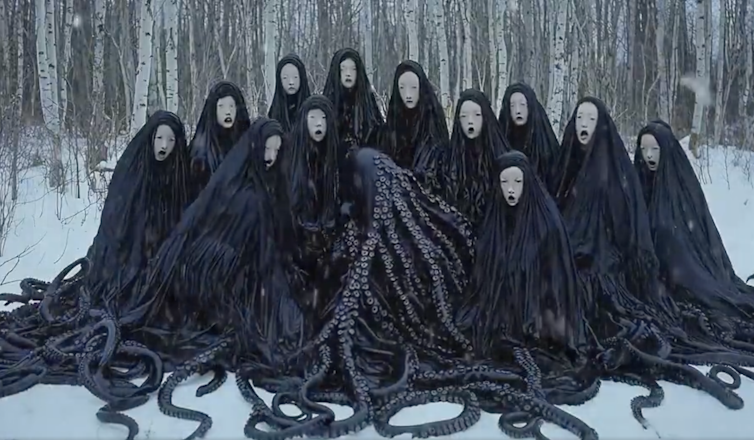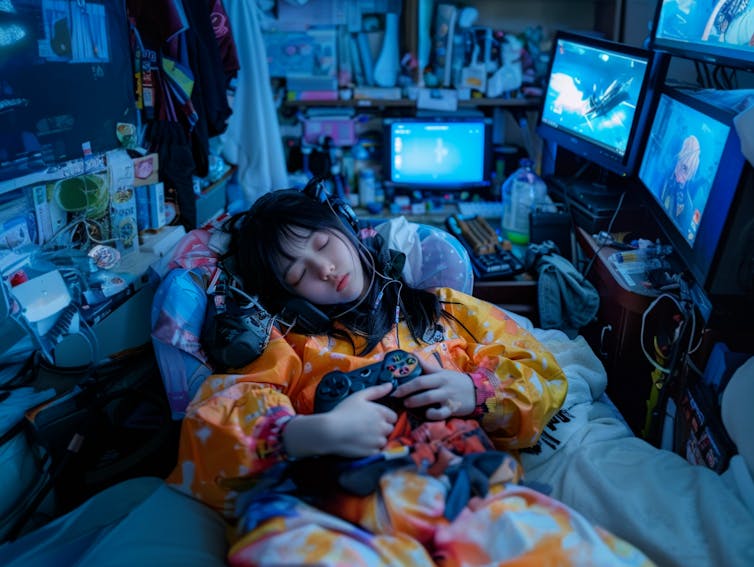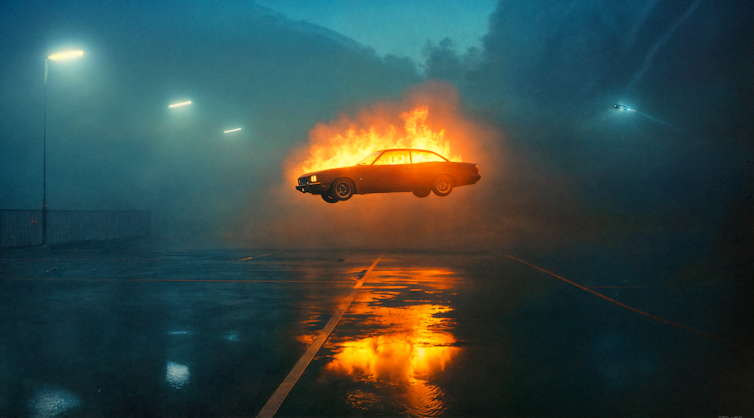Form textual content material into AI image and video generators, and likewise you’ll often see outputs of unusual, usually creepyphotographs.
In a way, it’s a perform, not a bug, of generative AI. And artists are wielding this aesthetic to create a model new storytelling paintings type.
The devices, harking back to Midjourney to generate pictures, Runway and Sora to produce films, and Forward AI to create 3D objects, are comparatively low value or free to utilize. They enable filmmakers with out entry to principal studio budgets or soundstages to make imaginative fast films for the worth of a month-to-month subscription.
I’ve studied these new works as a result of the co-director of the AI for Media & Storytelling studio on the School of Southern California.
Surveying the increasingly fascinating output of artists from across the globe, I partnered with curators Jonathan Wells and Meg Grey Wells to produce the Flux Pageanta four-day showcase of experiments in AI filmmaking, in November 2024.
Whereas this work stays dizzyingly eclectic in its stylistic vary, I would argue that it provides traces of notion into our fashionable world. I’m reminded that in every literary and film analysis, college students take into account that as cultures shift, so do the easiest way we inform tales.
With this cultural connection in ideas, I see 5 seen developments rising in film.
1. Morphing, blurring imagery
In her “NanoFictions” sequence, the French artist Caroline Georges creates portraits of transformation. In a single fast, “The Beast,” a burly man mutates from a two-legged human proper right into a hunched, skeletal cat, sooner than morphing proper right into a snarling wolf.
The metaphor – man is a monster – is obvious. Nevertheless what’s further compelling is the thrilling fluidity of transformation. There’s a giddy pleasure in seeing the decide’s seamless evolution that speaks to a very fashionable sensibility of shapeshifting all through our many digital selves.
This sense of transformation continues within the utilization of blurry imagery that, throughout the arms of some artists, turns into an aesthetic perform reasonably than a vexing draw back.
Theo Lindquist’s “Digital Dance Experiment #3,” for example, begins as a sequence of rapid-fire pictures displaying flashes of nude our our bodies in a cushty smear of pastel colors that pulse and throb. Steadily it turns into clear that this uncommon fluidity of flesh is a dance. Nevertheless the abstraction throughout the blur provides its private distinctive pleasure; the image is likely to be felt as lots as it could be seen.
2. The surreal
1000’s of TikTok films present how cringey AI pictures can get, nevertheless artists can wield that weirdness and craft it into one factor transformative. The Singaporean artist known as Niceaunties creates films that perform older women and cats, riffing on the concept of the “auntie” from Southeast and East Asian cultures.
In a single present video, the aunties let free clouds of extremely efficient hairspray to hold up not attainable towers of hair in a sequence that grows increasingly ridiculous. Similtaneously they’re playful and poignant, the flicks created by Niceaunties can pack a political punch. They contact upon assumptions about gender and age, for example, whereas moreover tackling fashionable factors harking back to air air pollution.
On the darker aspect, in a music video titled “Forest Under no circumstances Sleeps,” the artist known as Dopiidoo provides up hybrid octopus-women, guitar-playing rats, rooster-pigs and a wood-chopping ostrich-man. The seen chaos is a sweet match for the accompanying dying metal music, with surrealism returning as a powerful type.

Dopiidoo
3. Darkish tales
The customarily-eerie vibe of lots AI-generated imagery works successfully for chronicling fashionable ills, a undeniable fact that a lot of filmmakers use to stunning influence.
In “The Window,” Lucas Ortiz Estefanell of the AI firm SpecialGuestX pairs quite a few image sequences of people and areas with a contemplative voice-over to ponder ideas of actuality, privateness and the lives of artificially generated people. On the similar time, he wonders regarding the sturdy must create these synthetic worlds. “After I first watched this video,” recollects the narrator, “the which implies of the image ceased to make sense.”
Throughout the music video titled “Nearer,” based totally on a monitor by Iceboy Violet and nueen, filmmaker Mau Grunting captures the world-weary exhaustion of Gen Z by way of dozens of youthful characters slumbering, often beneath the inexperienced glow of video screens. The snapshot of a expertise that has come of age throughout the interval of social media and now artificial intelligence, pictured proper right here with telephones clutched close to their our our bodies as they murmur of their sleep, feels quietly wrenching.

Mau Grunting
4. Nostalgia
Sometimes filmmakers flip to AI to grab the earlier.
Rome-based filmmaker Andrea Ciulu makes use of AI to reimagine Nineteen Eighties East Coast hip-hop custom in “On These Streets,” which depicts city’s expanse and vitality by way of breakdancing as kids run by way of alleys after which spin magically up into the air.
Ciulu says that he wished to grab New York’s metropolis milieu, all of which he expert at a distance, from Italy, as a toddler. The video thus evokes a method of nostalgia for a mythic time and place to create a memory that can be hallucinatory.
Equally, David Slade’s “Shadow Rabbit” borrows black-and-white imagery reminiscent of the Nineteen Fifties to point infants discovering miniature animals crawling about on their arms. In just a few seconds, Slade depicts the enchanting creativeness of children and hyperlinks it to generated imagery, underscoring AI’s capacities for creating fanciful worlds.
5. New events, new areas
In his video for the monitor “The Hardest Half” by Washed Out, filmmaker Paul Trillo creates an infinite zoom that follows a gaggle of characters down the seemingly limitless aisle of a faculty bus, by way of the highschool cafeteria and out onto the freeway at night. The video fully captures the zoominess of time and the collapse of space for someone youthful and in love haplessly careening by way of the world.
The freewheeling digital digital camera moreover characterizes the work of Montreal-based duo Duhamel Valleywhose music video “The Pulse Inside” spins and twirls, careening up and spherical characters who’re reduce free from the authorized tips of gravity.
In every music films, viewers experience time and space as a blinding, topsy-turvy vortex the place the foundations of typical time and space not apply.

Provide
Correct now, in a world the place algorithms increasingly type frequently lifemany artworks are beginning to replicate how intertwined we’ve grow to be with computational applications.
What if machines are suggesting new strategies to see ourselves, as lots as we’re educating them to see like individuals?
